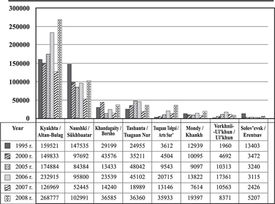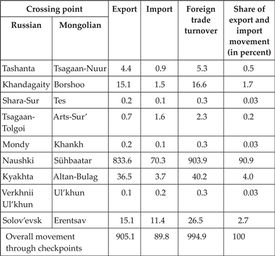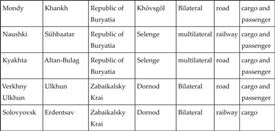Appendix 1: Border-Crossing Infrastructure: The Case of the Russian-Mongolian Border
| © Valentin Batomunkuev, CC-BY-NC-ND. | DOI: 10.11647/OBP.0026.13 |
The importance of cross-border cooperation between countries is a topical issue at a time when the increase of cross-border contacts plays an important part in international affairs and economic relations; Russia and its neighbouring countries in East and Southeast Asia are no exception. Yet the development of such cooperation is possible only if the border is seen not as a barrier but as a point of contact between countries. Such an active role, however, is made possible by a degree of border cooperation and is mediated by the border-crossing infrastructure.
In the specific, the border crossings in the Russian-Mongolian region studied in this appendix reveal a gap in the transport chain, a period of time during which the cargo or passengers remain immobile. Such delays bring additional costs which are especially significant at a time of increasing cargo and passenger traffic across the border.
For this reason, the Russian Federation now regards the fitting out and maintenance of border and customs infrastructure as a necessary step in the development of both its economic and diplomatic relations and its cross-border cooperation with Asian countries.
Border and customs infrastructure comprise the following:
•Border checkpoints.
•Border zones and the set of border regulations in place within their confines.
•Buildings, constructions, installations, engineering communications, telecommunication lines, power and water supplies, sources of electricity and water supplies, control devices and other technological equipment servicing crossing points.
•Road and railway networks, water transport and air routes.
•Border units, outposts, customs, customs offices, warehouses, terminals, residential houses for staff, etc.
The geographical area under consideration here is the Russian-Mongolian section of the state border, which passes through the territories of the four entities of the Russian Federation located within the Siberian federal district: the Altai Republic, Tuva, Buryatia and the Zabaikalsky Krai. Russia’s land borders are 22,170 km long and the border with Mongolia represents 15.7% of the total length (3,485 km). The total length of Mongolia’s border is 8161.9 km, 42.7% of it with Russia (along the Altai and Sayan mountain ranges), and the relatively flat section is confined to the valley of the Selenge River.
The Russian-Mongolian section of the border is characterised by a low checkpoint density, the average distance between permanent checkpoints being 387.2 km (Fig. 1).

Fig. 1 Transport and communication links of Russian and Mongolian border regions
The low checkpoint density in this area is due to the uniform distribution of checkpoints over the border regions of the Russian Federation: three functional checkpoints exist in the Zabaikalsky Krai, the Republic of Tuva and Buryatia. In the Altai Republic only one checkpoint is operational. Of these, four are multilateral, i.e. they allow passage of citizens of third countries. In addition these checkpoints provide the crossing line for vehicles of Kyakhta (Republic of Buryatia), Tashanta (Altai Republic) and Solovyovsk (Zabaikalsky Krai), and the railway crossing of Naushki (Republic of Buryatia).
A change of classification is currently under review for the multilateral road crossing point in Mondy (Republic of Buryatia). In 2009 and 2010, the Federal Agency for the Development of the State Border of the Russian Federation (Rosgranitsa) carried out a series of surveys of the conditions and operational state of checkpoints and other border and customs infrastructure. The study shows that of the 29 crossing points on the Russian-Mongolian border, only ten were properly equipped and fully operational. These ten checkpoints control virtually all freight and passenger traffic between Russia and Mongolia. Since April 2010, fourteen crossing points on the Russian-Mongolian border were closed as a prior study revealed that they were not functioning effectively due to lack of equipment and conflicting requirements by state bodies exercising control over checkpoints.
At present, nine permanent crossing points are operational along the Russian-Mongolian border, seven of them are road crossing points and two are railway crossing points.
The development of cross-border cooperation is not only a leading factor of regional integration, but it also strengthens the strategic partnership between countries. Figure 3, for example, provides data on the number of people who crossed the border during the period 1995–2008. In 2008, through eight checkpoints on the Russian-Mongolian border the number of arrivals and departures was 513,621. Out of these, 76.2% of passenger traffic crossed through the three checkpoints on the territory of the Republic of Buryatia: 52.3% through Kyakhta-Altan-Bulag, 20.1% through Naushki-Sühbaatar and 3.8% through Mondy-Khankh (Osodoev 2010).

Fig. 3 Number of people crossing the Russian-Mongolian border at border crossing points (1995–2008)
Figure 4 shows Mongolia’s export and import flux through the Russian-Mongolian border in 2007. The main cargo stream is transported through Naushki-Sühbaatar (90.9%), Kyakhta-Altan-Bulag (4.0%), Solov’evsk-Erentsav (2,7%), Khandagaity-Borshoo (1.7%).

Fig. 4 Mongolia’s exports and imports through checkpoints (2007, in million US dollars)
The relations between the two countries are currently reaching new heights on the basis of trade and economic partnerships and the development of border infrastructure, which is a crucial factor in cross-border cooperation. Recently a decision was made to give multilateral status to the “Khandagaity-Borshoo” and “Mondy-Khankh” checkpoints, to build customs and logistics terminals in the vicinity of the multilateral checkpoints of “Kyakhta-Altan-Bulag” and “Tashanta-Tsagaan Nuur” and to provide the necessary infrastructure.
A modernised infrastructure will increase traffic capacity while the equipping and modernisation of existing crossing points will enhance efficiency and reinforce a sense of spatial integration between countries. In establishing objectives and identifying the right approaches for the development of a border and customs infrastructure, a number of factors need to be taken into account:
•The current situation of the border and customs infrastructure.
•The existing legal framework governing this sector.
•The presence of specific historical, economic and socio-political conditions.
•The need for degrees of modernisation and allocation of financial resources to each crossing-point depending on its status and type (international, simplified, temporary, permanent, etc.).
•The divergent interests of the parties in the process of modernisation, maintenance and use of border infrastructures.
•Law violations in the operation of the checkpoints due to system faults and insufficient equipment.
The need to solve such challenging and often conflicting objectives led, in 2007, to the creation of the Federal Agency for the Development of the State Border of the Russian Federation (Rosgranitsa) whose mandate is the construction, technical equipment, and modernisation of checkpoints and border infrastructure. In the case of the Russian-Mongolian border, surveys conducted by Rosgranitsa reveal numerous shortcomings in the organisation of checkpoint activities. Although border checkpoints are being modernised they are still not well-integrated in the surrounding infrastructure, which is often obsolete. In particular, poor roads and communications and unreliable water and electricity supply inhibit the smooth functioning of these check-points.
It is difficult to calculate the costs involved in the modernisation of each crossing point due to the lack of reliable technical estimates. However, we can point out the main reasons for inadequate infrastructures, which include:
•Non-compliance to technological plans and practical technical issues.
•Non-compliance to required standards regarding the location of controlling devices, obsolete or faulty equipment, or its absence.
•Inadequate cross-border transport infrastructure for existing levels of traffic.
•Lack of territorial planning at checkpoint locations. This is often a source of conflict between parties during the modernisation work on checkpoints.
The inadequate state of checkpoints, which often stems from the inefficiency of federal agencies and institutions, has a negative effect on the economy of the region. It is crucial that the crossing points ensure a smooth commercial and passenger traffic through the state border. Hence the optimisation of border procedures must be a priority, in particular the shortening of control procedures, which has an immediate impact on checkpoints’ efficiency and competitiveness.
In the Russian Federation building, fitting out and equipping checkpoints, as well as opening, closing and limiting their activities are regulated by the law of the Russian Federation (“On the State Border of the Russian Federation”). The Russian State Duma is currently considering a draft bill “On amendments to some legislative acts of the Russian Federation in connection with the transfer of authority for the implementation of state control of the customs authorities by the Russian Federation”. The bill proposes that all forms of control at the border (except for issues of border protection such as transport, health, veterinary and phytosanitary control) should be under the jurisdiction of a single body – the Federal Customs Service. It also proposes that border checkpoints are in charge only of customs and border protection services while other types of border control (health, veterinary, etc.) would be handled by different authorities. The purpose of this bill is to reduce the transit time of goods through the checkpoints, and to implement a “one window” structure on the border (on the basis of the “single window” experiment used since 2008 at Pskov customs posts).
In 2011, a new federal law on border checkpoints was adopted across the border of the Russian Federation. The draft bill sets the legal regime of checkpoints along Russia’s state border and regulates the establishment, opening, operation and closure of checkpoints. Given the present state of checkpoints’ infrastructure, the shortage of budgetary funds and the economic losses incurred, priority should be given to the modernisation of all existing checkpoints, to facilitating cooperation between all federal and regional services concerned, as well as fostering a close collaboration with neighbouring states for the legal resolution of border issues.
Since 2011, the establishment of border infrastructures has been regarded as one of the priority areas in the development of the new federal target program “State Border of the Russian Federation” for the period up to 2017. Previously, within the framework of the programme “State Border of the Russian Federation (2003–2011)” headed by Rosgranitsa, the following major activities have been financed and implemented:

•Equipment of the state border in new areas; infrastructures were improved on the Russian-Ukrainian, Russian-Kazakh and Russian-Mongolian segments of the state border.
•Preparation of estimates and planning of road checkpoints (RC) on segments of the state border that were not fully equipped.
•Activation of new RC; reconstruction of numerous RC; installation and inspection of monitoring systems (MS); inspection of offices and industrial buildings, production bases and facilities.
•Equipment of numerous RC with systems for the reading and recognition of vehicle size and number plates; purchase and fitting on a temporary basis of portable x-ray inspection systems for checkpoints; acquisition of stationary x-ray inspection systems; provision of various weighing equipment, providing and restructuring state-integrated telecommunication networks.
The fitting out of the state border plays an important part in the Russian Federation’s border policy. The modern, technology-oriented look of a border is in the first place given by the checkpoints as they convey the “first impression” of a country, as well as being an important factor in the successful development of its foreign trade. As we have seen, however, the variable levels of technological compliance of checkpoints is slowing down the drive toward the modernisation of Russian borders.
Moreover, the development of cross-border cooperation contributes to the development of democratic processes in Russian-Mongolian relations and, as such, becomes an incentive for strengthening a strategic partnership. The role of cross-border cooperation is regarded by foreign and Russian scholars as a mechanism of socio-economic growth for border regions in the country. The development of modern infrastructures, including checkpoints, needs to be regarded as an area in which bordering countries cooperate. Such international cooperation is also needed for the development of tourism, the creation of trade and economic zones and the improvement of trade and economic activity, such as, for example, the supply of energy resources in Mongolia. The modernisation of border infrastructure (especially transport services, the service sector, the wholesale and retail trade in the municipalities and aimags)1 is thus needed for the socio-economic well-being of the people living in border areas who, by virtue of their geographic location, are in the best position to enjoy the advantages of international cooperation.
Footnotes
1An administrative subdivision in Mongolia.





